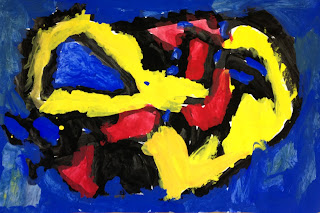After learning about using value to show a three-dimensional form in their still life drawings, 5th grade artists applied the same concept using a different material. We read the story, Snowmen at Night, and create our own sketches for what our snowmen (or snowpeople) could be doing in winter.
Some ideas we came up with included skiing, snowboarding, snowball fights, hockey and snowmen building other snowmen (very meta). In the sketch, students had to show some sort of action, and include a light source, whether it was the moon, a lamp or a fire.
Using their sketch to guide them, students then used chalk pastel to draw their own snowmen at night scene on larger colored paper. We discussed how to use other colors in combination with white to create a three-dimensional appearance to the snow.
For the areas of shadow, we used different shades of blue, purple, black and gray. For the areas of highlight, we used yellows and oranges to show light hitting a surface. This all depended on the light source in each student's work, and which side of the snowman was closest to it. Students enjoyed blending the soft pastel with their finger to blend colors together and fill in shapes.
The following class, we focused on adding details to the snowmen as well as the background. Students got creative with details, adding faces, winter accessories, trees, and even animals and creatures. We talked about how to add the shading and highlight to those details, such as the carrot nose or a top hat. Students looked at reference images to help them create snow capped trees and icy skating rinks.
As a finishing touch, some students chose to color in the sky so as to better hide chalk pastel finger prints and smudges. One student added the Northern Lights! Below are some examples of our snowmen at night drawings. Several students' drawings are featured on the December winter concert program and some of our other snowmen at night drawings will be on display in the glass case downstairs in January.
 |
| Adrina, 5th grade (Bellis)* |
 |
| Vicky, 5th grade (Bellis) |
 |
| Max, 5th grade (Bellis)* |
|
|
 |
| Anita, 5th grade (Domermuth Fantasia)* |
 |
Sandra, 5th grade (Bellis)
 |
| Daniel, 5th grade (Psychoghios) |
 |
| Kira, 5th grade (Bellis)* |
|
|
 |
| Alyce, 5th grade (Psychoghios)* |
 |
Greg, 5th grade (Psychoghios)
 |
| Catherine, 5th grade (Twomey) |
|
|
 |
| Ava, 5th grade (Psychoghios)* |
 |
Cristian, 5th grade (Domermuth Fantasia)
* indicates students featured on the Winter Concert program |
|
|
|
|
|


























































